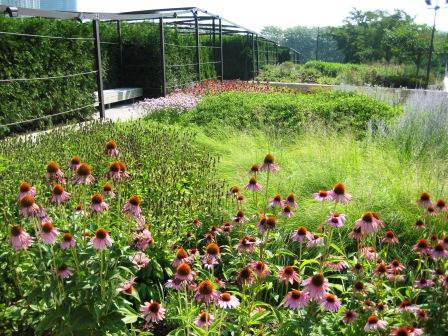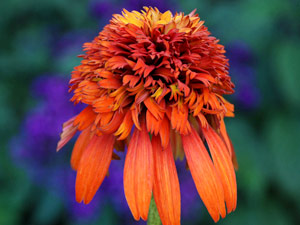
Echinacea purpurea 'Rubinglow' at the Lurie Garden in Chicago, IL
This winter I finalized a 10,000 square foot design for clients who reside in a rural setting in central Illinois. Their recently renovated Prairie Style home has lovely views of nearby timber and a vast meadow. The site and home lend themselves to a more naturalistic garden.
Coneflowers (Echinacea spp.) are in abundance in the design. As I’ve been submitting plant orders for the upcoming installation, they seemed an appropriate choice for May’s GGW Plant Pick of The Month.
Although there are nine species of coneflower, all native to central or eastern North America, purple coneflower (Echinacea purpurea) is the most commonly sold species at nurseries. Numerous cultivars have been developed for flower size and color, and plant size.
Several of my favorite Echinacea purpurea cultivars include:
- ‘Coconut Lime’ is the first double-flowered white coneflower. This cultivar has a relatively compact habit, only 24-30″ tall, with 20+ blooms per plant. It bloomed all summer from June-early September. ‘Coconut Lime’ pairs well with Russian sage (Perovskia atriplicifolia) and purple love grass (Eragrostis spectabilis).

- ‘Kim’s Knee High’ is the first dwarf purple coneflower, only 24″ tall with strongly reflexed pink petals. I enjoy ‘Kim’s Knee High’ adjacent to meadow sage (Salvia ‘May Night’), thousand flowered aster (Calamintha nepeta subsp. nepeta), thread-leaf bluestar (Amsonia hubrichtii), catmint (Nepeta ‘Walker’s Low’).
- ‘Ruby Giant’ has sturdy stems with multiple branches sporting 5-7″ wide flowers. The 30-36″ tall plants bloom from late June to frost. Perfect paired with switch grass (Panicum virgatum ‘Shenandoah’), rattlesnake master (Eryngium yuccifolium), sneezeweed (Helenium autumnale).
- I am anxious to trial Arie Blom’s latest introduction, ‘Hot Papaya’. Flowers are typically uniform in color and said not to fade. Blooms appear from June-August on 30″ tall plants.
Two other species of Echinacea I use on occasion are the pale purple coneflower (E. pallida) and the yellow coneflower (E. paradoxa). Both species combine particularly well with prairie dropseed (Sporobolus heterolepis).
Concerning cultural requirements, coneflowers are tolerant of most growing conditions but prefer well drained soil and full sun. Once established they are drought tolerant.
Do you have a favorite Echinacea purpurea cultivar or successful planting combinations including coneflowers you’d like to share? If so, simply post your comments below and link to your own site where you’ve posted photos of coneflowers and comments about your experiences working with the plant.


